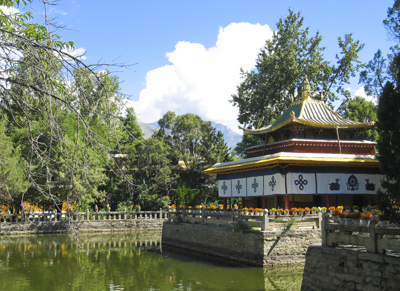August 19, 2007
The flight from Chengdu, China to Lhasa, Tibet took only two and a half hours and passed over snow-capped mountains. A local guide and driver met us at the airport and our small group of five teachers began to acclimate to an altitude of 12,000 feet.

Our guide gave each of us a long white silk scarf, called a hada. He said they were traditional gifts of welcome to visitors. The hada symbolizes the giver’s sincere heart.

It was about an hour’s drive to the capital city but we stopped on the way to see the Nietang Buddha. The 32 foot high statue was engraved on the side of a cliff by the disciples of the nearby Neitang Tara Buddhist Temple.

People throw their hadas on the cliff to show respect to the Buddha. The higher, the better. Our guide told us it was good luck, but none of us wanted to part with our gift.

After spending many days in the smog-covered cities of mainland China, I enjoyed the crystal clear air and sunshine of one of the highest altitude cities in the world.


We slowly drove to our hotel and checked in:


Lobby of the hotel:

The inner courtyard was filled with potted plants and prayer flags flapped in the breeze.

We were told to rest and relax to get acclimated to the thin air. “Slow and steady” was the name of the game. After a couple of hours, we went out to see Lhasa:


The next morning after breakfast in the hotel, we drove to visit Norbulingka which translates to “Jeweled Park.” This was the summer residence of every Dalai Lama since 1780 until the current 14th Dalai Lama’s exile in 1959.



Entrance to the palace:



The complex consisted of several buildings and a 3-story palace with rooms for prayer, bedrooms, and reading rooms surrounded by a magnificent garden filled with trees and flowers.



After suffering extensive damage during the Cultural Revolution, the Chinese government began to restore the complex in 2003 and turned the grounds into a public park. Norbulingka is a UNESCO World Heritage Site.

